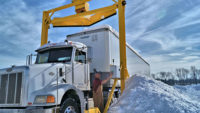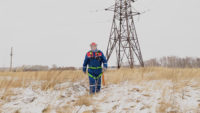No matter the weather, over-the-road deliveries are expected to arrive on time. In colder climates, that means drivers must brave wintry conditions to get from a warehouse or manufacturer to a seller or end user.
Snow and ice on roadways make for dangerous driving. However, when snow and ice blow off semi-trailers and trucks, the risk factors for drivers and carrier responsibility increase dramatically. Not surprisingly, many states impose fines on carriers who don’t sufficiently remove snow.
Unfortunately, that removal process can be costly and dangerous if done manually with snow rakes and shovels. Fortunately, there is a way to remove snow quickly, safely, and efficiently from trailers with automated machines to help keep fleets clean and running on time.
Truck drivers often have the responsibility of removing snow from their roofs. There are several ways of doing this, some of which put the driver at risk. Options for clearing rooftop snow include:
- Climbing to the top of the trailer and using a shovel
- Using a snow rake from the ground
- Driving through an automated snow removal machine
While the shovel or rake are considered more traditional methods, they take time and put drivers and employees in harm’s way.
The danger of snow on vehicle rooftops
Of course, there’s always the option to leave snow on the rooftops. But with the potential of fines — and a guilty conscience — it’s quite a risky one. Once the danger of snow and ice on rooftops is understood, it’s clear this isn’t a real option.
When snow isn’t removed from vehicle rooftops, freezing and thawing can turn snow into a solid ice block that threatens the drivers of vehicles driving behind them. This phenomenon can be disastrous on larger vehicles like semi-trailers, since they have significantly more surface area for snow and ice to accumulate and a higher launch point. Even if the rooftop snow isn’t frozen solid, it may blow off onto nearby motorists, disrupting the driver’s vision and potentially causing crashes. Because snow and ice are most likely to fall during high rates of speed (like on highways) and changes of direction (like turns at intersections), these vehicle crashes tend to be serious.
Failure to remove snow from a trailer rooftop isn’t really an option unless the driver and managing company want to risk a life-changing or life-ending event for other drivers on the road.
It’s the law
And if risking lives isn’t reason enough, simply traveling with snow on a roof can result in a ticket, fine, or driver suspension.
Laws against commercial vehicles traveling with snow-covered roofs have been enacted in Connecticut, New Hampshire, Rhode Island, New Jersey, Quebec, and most recently in Pennsylvania. New laws are pending in New York, Massachusetts, and Delaware. Depending on the location, fines range from $75 for failure to clear a vehicle to $1,500 per offense plus a court appearance. For example, in Quebec fines can be up to $200 for driving vehicles covered with snow, ice or any other matter that may detach from the vehicle and be hazardous for road users.
Fines aren’t the only penalty that commercial drivers face. Failure to remove snow can also lead to the revocation of their commercial driver’s license, points assessed to their driving record, temporary or permanent loss of job, and higher insurance rates.
Even in areas where specific snow laws don’t exist, all commercial transport vehicles are required to secure their loads while traveling on roadways. Snow and ice on top of a trailer can be considered unsecured and drivers can be fined.
Snow removal: the hard way
Manually removing snow from trailers that are 12-plus feet tall requires people using snow brushes and rakes, as well as ladders. In wintry conditions, the possibility of slipping increases, as do injuries such as sprained or broken ankles and legs or separated shoulders. Additionally, even the best snow brush and rake equipment still pulls snow downward near (or onto) the person clearing the snow. And the intense physical labor of manually removing snow for 30 minutes or longer can lead to cardiac events.
Truck and trailer roof snow removal is tough on truck fleets. Injuries to drivers and workers not only exacerbate the existing shortage of truck drivers and cause delivery delays, they may expose the employer to higher workers’ compensation claim costs.
Additionally, the stress of having to remove snow can lead to compromised mental and emotional states of employees. While the single act might not be detrimental, it can add up with the other stresses of delivering goods on time in wintry conditions. Stress of fleet managers and yard crews who might have to worry about removing snow from rooftops can also be damaging.
Remove snow safely and efficiently
Snow removal doesn’t have to be a labor-intensive ordeal fraught with the risk of injury and stress. There’s a safer, more efficient way to remove snow from tall trailer rooftops: plow assemblies that scrape snow off the tops of trucks/trailers when they pass under it.
This seemingly simple concept can provide substantial safety and efficiency benefits. Removing snow from truck and trailer roofs can help reduce the risk of ice missiles creating turmoil on North American roadways.
Different makes and models of snow removal machines allow fleet managers and yard managers to specify the right option for their facility and fleet. The most advanced versions can remove 2 feet of snow in less than 30 seconds, allowing a fleet of 60 vehicles to be completely cleaned off in an hour using an adjustable height plow assembly. These systems accommodate a wide range of vehicles including common last-mile delivery vehicles—box trucks, dry van trailers, cargo vans with rounded roof edges, passenger vans — and containers built for intermodal travel.
The most high-performing snow removal machines use an efficient patented V-shaped plow blade. Other snow removal configurations include straight plow blades, rolling brushes, and blowers. It’s important to find a model that is tough enough to remove heavy snow but won’t damage the rooftops of trailers.
Some versions have an automated feature that requires an operator merely to push buttons for quick and easy snow removal. Certain snow removal machines are even portable, so they can be moved out of the way and stored during warmer seasons. As winter gives way to spring, portability of these snow removal machines can be more than just a nice perk, it becomes essential in yards to maximize their footprint.
Safer roads, more productive drivers
Removing snow from truck and trailer rooftops is critical to help keep roadways safe for all motorists during winter months. It will also limit exposure to tickets, fines, and license suspensions for drivers. There are several snow removal techniques to consider, but not all provide the same level of safety and efficiency as automated snow removal options. For facilities and fleet managers that want to emphasize safety and productivity, an investment in carefully evaluated snow-removal machines is wise.







